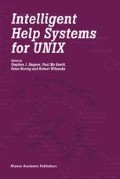Abstract
The language used to describe technical domains like UNIX is filled with metaphor. An approach to metaphor, based on the explicit representation of knowledge about metaphors, has been developed. MIDAS (Metaphor Interpretation, Denotation, and Acquisition System) is a computer program that that has been developed based upon this approach. MIDAS can be used to represent knowledge about conventional metaphors, interpret metaphoric language by applying this knowledge, and dynamically learn new metaphors as they are encountered during normal processing.
Access this chapter
Tax calculation will be finalised at checkout
Purchases are for personal use only
Preview
Unable to display preview. Download preview PDF.
References
Carbonell, J. (1981). Invariance Hierarchies in Metaphor Interpretation. In Proceedings of the Third Meeting of the Cognitive Science Society, 292–295. Berkeley, CA: Cognitive Science Society.
Dejong, G. F. & Waltz, D. L. (1983). Understanding Novel Language. Computers and Mathematics with Applications 9(1): 131–147.
Fass, D. (1988). Collative Semantics: A Semantics for Natural Language. Ph.D. diss., New Mexico State University, Las Cruces, New Mexico. CRL Report No. MCCS-88-118.
Gentner, D., Falkenhainer B. & Skorstad J. (1988). Viewing Metaphor as Analogy. In Helman, D. (ed.) Analogical Reasoning. Dordrecht: Kluwer Academic Publishers.
Indurkhya, B. (1987). Approximate Semantic Transference: A Computational Theory of Metaphors and Analogy. Cognitive Science 11(4): 445–480.
Jacobs, P. S. (1985). A Knowledge-Based Approach to Language Production. Ph.D. diss., University of California, Berkeley, Computer Science Department, Berkeley, CA. Report No. UCB/CSD 86/254.
Lakoff, G. & Johnson, M. (1980). Metaphors We Live By. Chicago, Illinois: University of Chicago Press.
Martin, J. H. (1986). The Acquisition of Polysemy. In The Proceedings of the Fourth International Conference on Machine Learning, 198–204. Irvine, CA
Martin, J. H. (1987). Understanding New Metaphors. In The Proceedings of the Tenth International Joint Conference on Artificial Intelligence, 137–139. Milan, Italy.
Martin, J. H. (1988). A Computational Theory of Metaphor. Ph.D. diss., University of California, Berkeley, Computer Science Department, Berkeley, CA. Report No. UCB/CSD 88—465.
Martin, J. H. (1990). A Compututational Model of Metaphor Interpretation. Cambridge, MA: Academic Press.
Martin, J. H. (1992). Computer Understanding of Conventional Metaphoric Language. Cognitive Science 16(2): 233–270.
Martin, J. H. (1994). Metabank: A Knowledge-base of Metaphoric Language Conventions. Computational Intelligence 10(2): 134–149.
Norvig, P. (1987). A Unified Theory of Inference for Text Understanding. Ph.D. diss., University of California, Berkeley, Computer Science Department, Berkeley, CA. Report No. UCB/CSD 87-339.
Wilensky, R. (1986). Some Problems and Proposals for Knowledge Representation. Technical Report UCB/CSD 86/294, University of California, Berkeley, Computer Science Division.
Wilensky, R. (1987). Primal Content and Actual Content: An Antidote to Literal Meaning. Technical Report UCB/CSD 87/365, University of California, Berkeley, Computer Science Division.
Wilensky, R., Chin D., Luria M., Martin J., Mayfield J., & Wu D. (1988). The Berkeley UNIX Consultant Project. Computational Linguistics 14(4): 35–84.
Author information
Authors and Affiliations
Editor information
Rights and permissions
Copyright information
© 2000 Springer Science+Business Media Dordrecht
About this chapter
Cite this chapter
Martin, J.H. (2000). Representing UNIX Domain Metaphors. In: Hegner, S.J., Mc Kevitt, P., Norvig, P., Wilensky, R. (eds) Intelligent Help Systems for UNIX. Springer, Dordrecht. https://doi.org/10.1007/978-94-010-0874-7_17
Download citation
DOI: https://doi.org/10.1007/978-94-010-0874-7_17
Publisher Name: Springer, Dordrecht
Print ISBN: 978-94-010-3790-7
Online ISBN: 978-94-010-0874-7
eBook Packages: Springer Book Archive

